Q1: The circuit shown in the figure with the switch S open, is in steady state. After the switch S is closed, the time constant of the circuit in seconds is (2024)
 (a) 1.25
(a) 1.25
(b) 0
(c) 1
(d) 1.5
Ans: (a)
Sol: 
Q2: The circuit shown in the figure is initially in the steady state with the switch K in open condition and  in closed condition. The switch K is closed and
in closed condition. The switch K is closed and  is opened simultaneously at the instant t = t1, where t1 > 0. The minimum value of t1 in milliseconds, such that there is no transient in the voltage across the 100μF capacitor, is ___ (Round off to 2 decimal places). (2023)
is opened simultaneously at the instant t = t1, where t1 > 0. The minimum value of t1 in milliseconds, such that there is no transient in the voltage across the 100μF capacitor, is ___ (Round off to 2 decimal places). (2023)
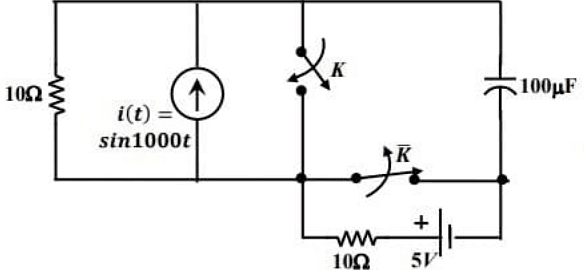 (a) 0.87
(a) 0.87
(b) 1.57
(c) 1.88
(d) 2.26
Ans: (b)
Sol: Switch K is open and  is closed.
is closed.
Redraw the circuit :
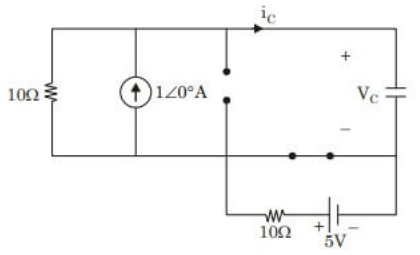 From circuit, using current division,
From circuit, using current division,

 Case (ii) :
Case (ii) :
Switch K is closed and is open.
is open.
Current source and 10Ω resistor becomes short circuited.
Redraw the circuit :
 From circuit,
From circuit,

 We have,
We have,
 For transient free voltage,
For transient free voltage,


Q3: In the circuit shown below, the switch S is closed at t = 0. The magnitude of the steady state voltage, in volts, across the 6Ω resistor is _________. (round off to two decimal places). (2022)
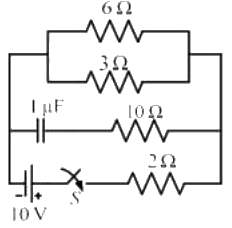 (a) 5
(a) 5
(b) 8.25
(c) 12.55
(d) 3.35
Ans: (a)
Sol: Concept: At steady state, capacitor behaves as open circuit.
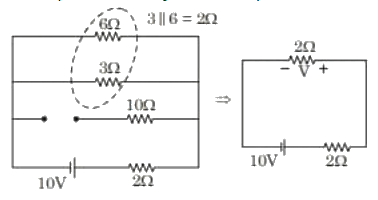 Using voltage division,
Using voltage division,

Q4: A 100 Hz square wave, switching between 0 V and 5 V, is applied to a CR high-pass filter circuit as shown. The output voltage waveform across the resistor is 6.2 V peak-to-peak. If the resistance R is 820 Ω, then the value C is ______________ μF. (Round off to 2 decimal places.) (2021)
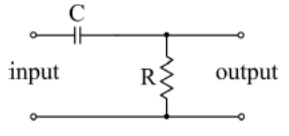 (a) 18.5
(a) 18.5
(b) 12.46
(c) 10.06
(d) 15.48
Ans: (b)
Sol: 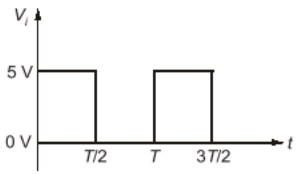

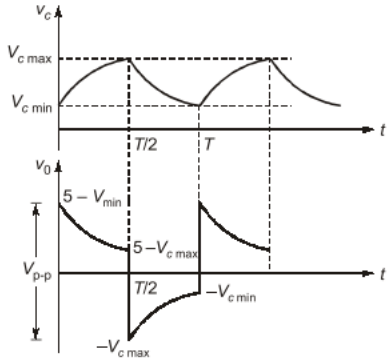




 ∴
∴
 ⇒
⇒ 

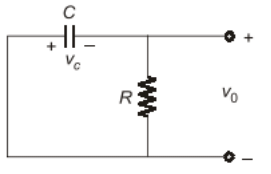
 ∴
∴ 

 From (ii),
From (ii),
 ⇒
⇒ 
 Using equation (iii)
Using equation (iii)
 ⇒
⇒ 
⇒ 
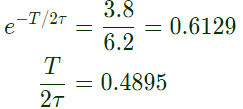 as
as  and
and  ⇒
⇒ 
∴ C = 12.46 μF
Q5: In the circuit, switch 'S' is in the closed position for a very long time. If the switch is opened at time t = 0, then in iL(t) amperes, for t ≥ 0 is (2021)
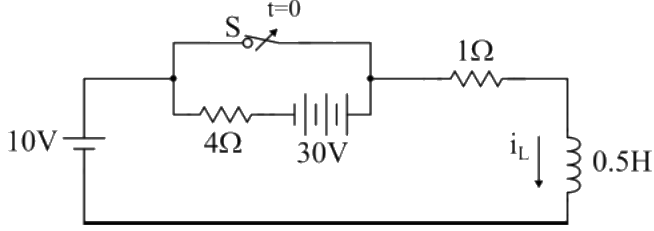 (a) 8e-10t
(a) 8e-10t
(b) 10
(c) 8 + 2e-10t
(d) 10(1 - e-2t)
Ans: (c)
Sol: 
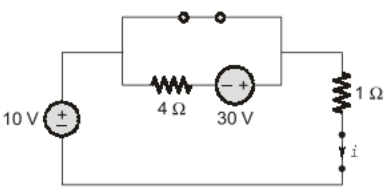

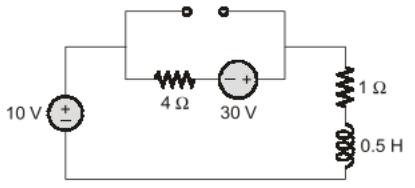 At t = ∞
At t = ∞
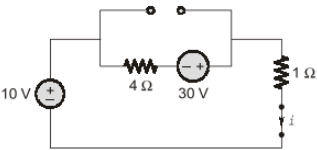

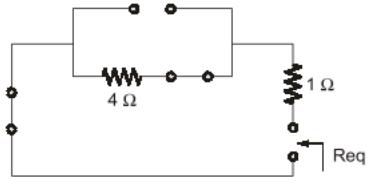
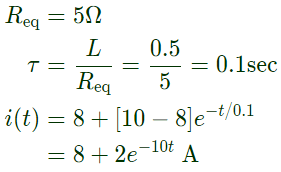
Q6: The initial charge in the 1 F capacitor present in the circuit shown is zero. The energy in joules transferred from the DC source until steady state condition is reached equals ______. (Give the answer up to one decimal place.) (SET-2 (2017))
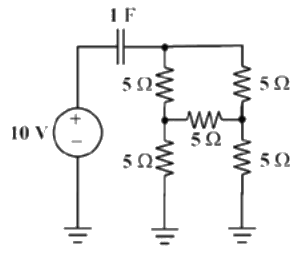 (a) 100
(a) 100
(b) 200
(c) 50
(d) 400
Ans: (a)
Sol: Consider the following circuit diagram,
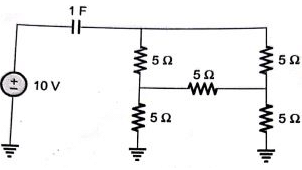 After minimizing circuit elements we can have the following circuit,
After minimizing circuit elements we can have the following circuit,
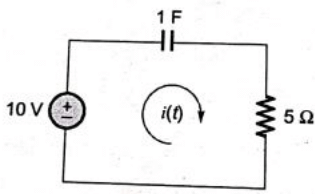
 Energy supplied by the source,
Energy supplied by the source,

Q7: The switch in the figure below was closed for a long time. It is opened at t = 0. The current in the inductor of 2 H for t ≥ 0, is (SET-1 (2017))
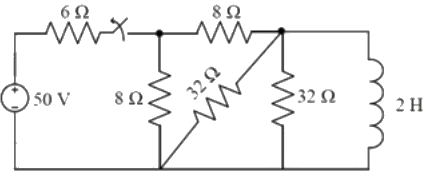 (a) 2.5 e-4t
(a) 2.5 e-4t
(b) 5e-4t
(c) 2.5e-0.25t
(d) 5e-0.25t
Ans: (a)
Sol: From the given circuit, consider the following circuit diagram,
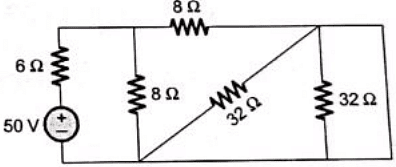 After rearrangement
After rearrangement
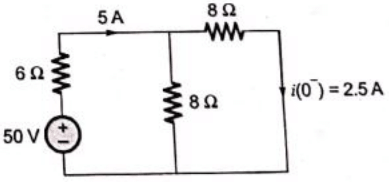
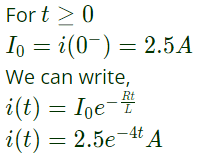
Q8: In the circuit shown below, the initial capacitor voltage is 4 V. Switch S1 is closed at t = 0. The charge (in μC) lost by the capacitor from t = 25 μs to t = 100 μs is ____________. (SET-2(2016))
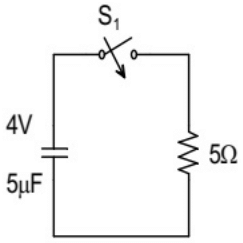 (a) 5
(a) 5
(b) 6
(c) 7
(d) 8
Ans: (c)
Sol: 
 Change lost by capacitor from t = 25 μs to 100 μs is
Change lost by capacitor from t = 25 μs to 100 μs is

Q9: In the circuit shown, switch S2 has been closed for a long time. At time t = 0 switch S1 is closed. At t = 0+, the rate of change of current through the inductor, in amperes per second, is _____. (SET-1 (2016))
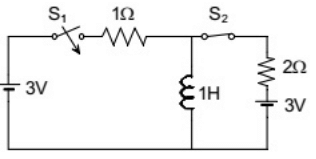 (a) 1
(a) 1
(b) 2
(c) 3
(d) 4
Ans: (b)
Sol: 
 KCL at node A,
KCL at node A,
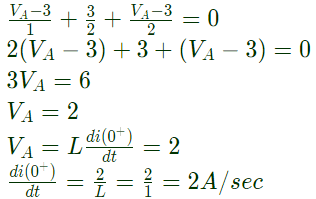
Q10: A series RL circuit is excited at t = 0 by closing a switch as shown in the figure. Assuming zero initial conditions, the value of  is (SET-2 (2015))
is (SET-2 (2015))
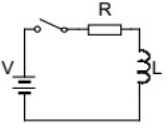 (a) V/L
(a) V/L
(b) (-V)/R
(c) 0
(d) (-RV)/(L2)
Ans: (d)
Sol: 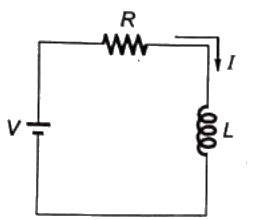 Initially (t = 0−) the inductor would be uncharged.
Initially (t = 0−) the inductor would be uncharged.
So, I(0+) = 0
The KVL in th loop will be
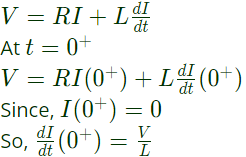 Now, lets differentiate the above equation
Now, lets differentiate the above equation
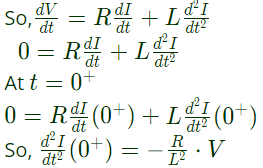
Q11: The switch SW shown in the circuit is kept at position '1' for a long duration. At t = 0+, the switch is moved to position '2'. Assuming ∣Vo2∣ > ∣Vo1∣, the voltage vc(t) across the capacitor is (SET-2 (2014))
 (a)
(a) 
(b) 
(c) 
(d) 
Ans: (d)
Q12: A combination of 1 μF capacitor with an initial voltage vc(0) = −2V in series with a 100 Ω resistor is connected to a 20 mA ideal dc current source by operating both switches at t = 0s as shown. Which of the following graphs shown in the options approximates the voltage vs across the current source over the next few seconds ? (SET-1 (2014))
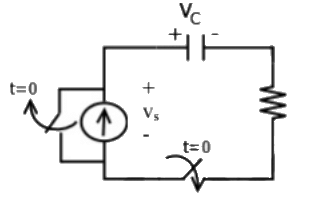 (a)
(a) 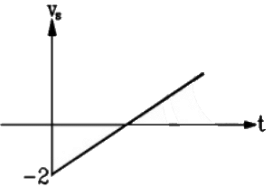 (b)
(b)  (c)
(c) 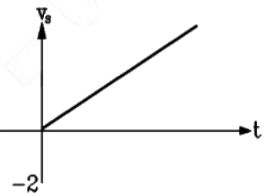 (d)
(d) 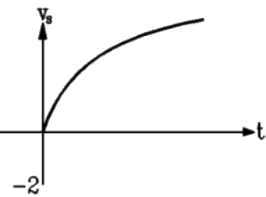 Ans: (c)
Ans: (c)
Sol: Given C =1μF, Vc(0) = −2V, R= 100Ω, I = 20mA. Circuit fot the given condition at time t > 0 is shown below:
 Applying KVL, we have,
Applying KVL, we have, 
 Putting values of R, C and I, we get,
Putting values of R, C and I, we get,
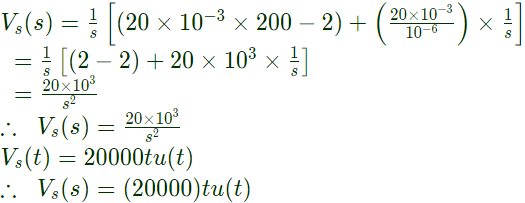 Which is equation of a straight line passing through origin. Hence option (C) is correct.
Which is equation of a straight line passing through origin. Hence option (C) is correct.
Q13: In the following figure, C1 and C2 are ideal capacitors. C1 has been charged to 12 V before the ideal switch S is closed at t = 0. The current i(t) for all t is (2012)
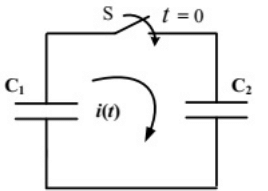 (a) zero
(a) zero
(b) a step function
(c) an exponentially decaying function
(d) an impulse function
Ans: (d)
Sol: 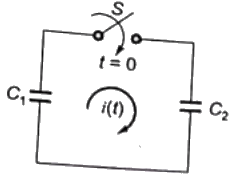 Circuit is s-domain
Circuit is s-domain
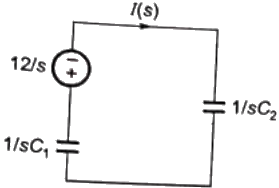 By applying KVL,
By applying KVL,
 ∴ Current i(t) is an implulse function.
∴ Current i(t) is an implulse function.
Q14: The L-C circuit shown in the figure has an inductance L = 1mH and a capacitance C = μF.
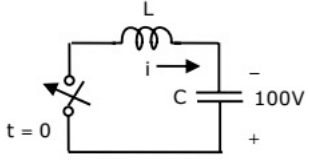 The initial current through the inductor is zero, while the initial capacitor voltage is 100 V. The switch is closed at t = 0. The current i through the circuit (2010)
The initial current through the inductor is zero, while the initial capacitor voltage is 100 V. The switch is closed at t = 0. The current i through the circuit (2010)
(a) 5cos(5 × 103t)A
(b) 10sin(104t)A
(c) 10cos(5 × 103t)A
(d) 10sin(104t)A
Ans: (d)
Sol: Initial current through the inductor is zeroand capacitor voltage is charged upto voltage Vc(0−) = 100V
As current through inductor and voltage across capacitor can not change abruptly
So, after closing the switch,
 The circuit id s-domain
The circuit id s-domain

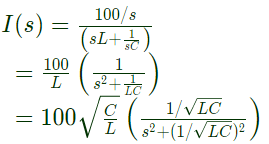 taking inverse laplace transform
taking inverse laplace transform
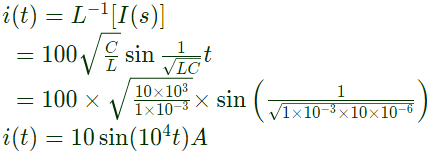
Q15: The switch in the circuit has been closed for a long time. It is opened at t = 0. At t = 0+ , the current through the 1 μF capacitor is (2010)
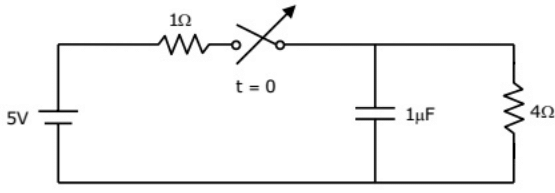 (a) 0A
(a) 0A
(b) 1A
(c) 1.25 A
(d) 5A
Ans: (b)
Sol: As the switch has been closed for a long time, the circuit is in steady state. At steadystate, capacitor is open circuit,
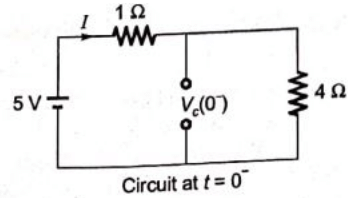 Using KVL,
Using KVL,
 As the voltage across capacitorcan not change abruptly,
As the voltage across capacitorcan not change abruptly,

 Current through capacitor at t = 0+
Current through capacitor at t = 0+

 (a) 1.25
(a) 1.25
 in closed condition. The switch K is closed and
in closed condition. The switch K is closed and  is opened simultaneously at the instant t = t1, where t1 > 0. The minimum value of t1 in milliseconds, such that there is no transient in the voltage across the 100μF capacitor, is ___ (Round off to 2 decimal places). (2023)
is opened simultaneously at the instant t = t1, where t1 > 0. The minimum value of t1 in milliseconds, such that there is no transient in the voltage across the 100μF capacitor, is ___ (Round off to 2 decimal places). (2023) (a) 0.87
(a) 0.87 is closed.
is closed. From circuit, using current division,
From circuit, using current division,
 Case (ii) :
Case (ii) : is open.
is open. From circuit,
From circuit,
 We have,
We have, For transient free voltage,
For transient free voltage,

 (a) 5
(a) 5 Using voltage division,
Using voltage division,
 (a) 18.5
(a) 18.5






 ∴
∴
 ⇒
⇒ 


 ∴
∴ 

 From (ii),
From (ii), ⇒
⇒ 
 Using equation (iii)
Using equation (iii) ⇒
⇒ 

 as
as  and
and  ⇒
⇒ 
 (a) 8e-10t
(a) 8e-10t


 At t = ∞
At t = ∞



 (a) 100
(a) 100 After minimizing circuit elements we can have the following circuit,
After minimizing circuit elements we can have the following circuit,
 Energy supplied by the source,
Energy supplied by the source,
 (a) 2.5 e-4t
(a) 2.5 e-4t After rearrangement
After rearrangement

 (a) 5
(a) 5
 Change lost by capacitor from t = 25 μs to 100 μs is
Change lost by capacitor from t = 25 μs to 100 μs is
 (a) 1
(a) 1
 KCL at node A,
KCL at node A,
 is (SET-2 (2015))
is (SET-2 (2015)) (a) V/L
(a) V/L Initially (t = 0−) the inductor would be uncharged.
Initially (t = 0−) the inductor would be uncharged. Now, lets differentiate the above equation
Now, lets differentiate the above equation
 (a)
(a) 



 (a)
(a)  (b)
(b)  (c)
(c)  (d)
(d)  Ans: (c)
Ans: (c) Applying KVL, we have,
Applying KVL, we have, 
 Putting values of R, C and I, we get,
Putting values of R, C and I, we get, Which is equation of a straight line passing through origin. Hence option (C) is correct.
Which is equation of a straight line passing through origin. Hence option (C) is correct. (a) zero
(a) zero Circuit is s-domain
Circuit is s-domain By applying KVL,
By applying KVL, ∴ Current i(t) is an implulse function.
∴ Current i(t) is an implulse function. The initial current through the inductor is zero, while the initial capacitor voltage is 100 V. The switch is closed at t = 0. The current i through the circuit (2010)
The initial current through the inductor is zero, while the initial capacitor voltage is 100 V. The switch is closed at t = 0. The current i through the circuit (2010) The circuit id s-domain
The circuit id s-domain
 taking inverse laplace transform
taking inverse laplace transform
 (a) 0A
(a) 0A Using KVL,
Using KVL, As the voltage across capacitorcan not change abruptly,
As the voltage across capacitorcan not change abruptly,
 Current through capacitor at t = 0+
Current through capacitor at t = 0+





















